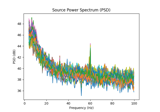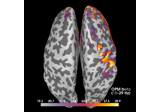mne.minimum_norm.compute_source_psd#
- mne.minimum_norm.compute_source_psd(raw, inverse_operator, lambda2=0.1111111111111111, method='dSPM', tmin=0.0, tmax=None, fmin=0.0, fmax=200.0, n_fft=2048, overlap=0.5, pick_ori=None, label=None, nave=1, pca=True, prepared=False, method_params=None, inv_split=None, bandwidth='hann', adaptive=False, low_bias=False, n_jobs=None, return_sensor=False, dB=False, *, verbose=None)[source]#
Compute source power spectral density (PSD).
- Parameters:
- rawinstance of
Raw The raw data.
- inverse_operatorinstance of
InverseOperator The inverse operator.
- lambda2
float The regularization parameter.
- method“MNE” | “dSPM” | “sLORETA”
Use minimum norm, dSPM (default), sLORETA, or eLORETA.
- tmin
float The beginning of the time interval of interest (in seconds). Use 0. for the beginning of the file.
- tmax
float|None The end of the time interval of interest (in seconds). If None stop at the end of the file.
- fmin
float The lower frequency of interest.
- fmax
float The upper frequency of interest.
- n_fft
int Window size for the FFT. Should be a power of 2.
- overlap
float The overlap fraction between windows. Should be between 0 and 1. 0 means no overlap.
- pick_ori
None| “normal” If “normal”, rather than pooling the orientations by taking the norm, only the radial component is kept. This is only implemented when working with loose orientations.
- label
Label Restricts the source estimates to a given label.
- nave
int The number of averages used to scale the noise covariance matrix.
- pcabool
If True, the true dimension of data is estimated before running the time-frequency transforms. It reduces the computation times e.g. with a dataset that was maxfiltered (true dim is 64).
- preparedbool
If True, do not call
prepare_inverse_operator().- method_params
dict|None Additional options for eLORETA. See Notes of
apply_inverse().New in version 0.16.
- inv_split
intorNone Split inverse operator into inv_split parts in order to save memory.
New in version 0.17.
- bandwidth
float|str The bandwidth of the multi taper windowing function in Hz. Can also be a string (e.g., ‘hann’) to use a single window.
For backward compatibility, the default is ‘hann’.
New in version 0.17.
- adaptivebool
Use adaptive weights to combine the tapered spectra into PSD (slow, use n_jobs >> 1 to speed up computation).
New in version 0.17.
- low_biasbool
Only use tapers with more than 90% spectral concentration within bandwidth.
New in version 0.17.
- n_jobs
int|None The number of jobs to run in parallel. If
-1, it is set to the number of CPU cores. Requires thejoblibpackage.None(default) is a marker for ‘unset’ that will be interpreted asn_jobs=1(sequential execution) unless the call is performed under ajoblib.parallel_backend()context manager that sets another value forn_jobs. It is only used if adaptive=True.New in version 0.17.
- return_sensorbool
If True, return the sensor PSDs as an EvokedArray.
New in version 0.17.
- dBbool
If True (default False), return output it decibels.
New in version 0.17.
- verbosebool |
str|int|None Control verbosity of the logging output. If
None, use the default verbosity level. See the logging documentation andmne.verbose()for details. Should only be passed as a keyword argument.
- rawinstance of
- Returns:
- stc_psdinstance of
SourceEstimate|VolSourceEstimate The PSD of each of the sources.
- sensor_psdinstance of
EvokedArray The PSD of each sensor. Only returned if
return_sensoris True.
- stc_psdinstance of
See also
Notes
Each window is multiplied by a window before processing, so using a non-zero overlap is recommended.
This function is different from
compute_source_psd_epochs()in that:bandwidth='hann'by default, skipping multitaper estimationFor convenience it wraps
mne.make_fixed_length_events()andmne.Epochs.
Otherwise the two should produce identical results.
Examples using mne.minimum_norm.compute_source_psd#

Compute source power spectral density (PSD) in a label

Compute source power spectral density (PSD) of VectorView and OPM data